Even rocks in wire boxes improve driving experience

Pretty matters. Or, more precisely, the way a thing looks can affect the way you interact with it.
This is important, and we all know it already.
It’s why Sheriff Joe Arpaio over in Maricopa County, Ariz., painted his jail pink.
It’s why terms like “curb appeal” have caught on.
And it’s why driving on the Las Vegas Beltway around Cheyenne Avenue is so darn depressing. You’ve got gray surrounded by gray with a touch of gray.
■ ■ ■
Luann wrote in a few weeks back with this observation: “Hello, I’ve noticed rocks in wire mesh boxes at some of the on/off ramp exits. They look fabulous!”
She wanted to know how they get the rocks into those boxes, and she wanted to know if she could buy them.
Very carefully, Luann, and yes.
Spokesman Damon Hodge said the Nevada Department of Transportation spends about 3 percent of the budget on big projects on aesthetics. The new part of Interstate 15 in the southern part of town includes steel sculptures of sheep, coyotes, horses, burros, hawks and reptiles, along with some native plants that don’t need a lot of water.
The wire mesh things are called gabions. They’re typically used in civil engineering projects, like stabilizing river banks or controlling runoff.
But they also look cool.
Take note the next time you’re on U.S. Highway 95 around Flamingo Road or Tropicana Avenue. Those gabions were manufactured by the Gabion Supply Co., Hodge said. You can look them up online at http://gabionbaskets.net.
The process for fashioning these cool art pieces is outlined on the website, but I’ll summarize for you:
1. Build a wire cage;
2. Fill it with rocks.
Tada! Pretty.
■ ■ ■
Steve wrote in with a gripe: “The train bridge over West Charleston (Boulevard) is a disgrace.”
He noted several problems, including missing concrete, stickers and graffiti, and bent or missing pedestrian railings.
I checked with Diana Paul, a city of Las Vegas spokeswoman, who thanked Steve for bringing it up.
She noted that Charleston is under the Department of Transportation’s jurisdiction, while the bridge is the property of Union Pacific, and the whole mess is in the city; so the sidewalks are the city’s responsibility.
So, she said the three entities will work together to fix it. Nobody wants to drive through that ugliness.
■ ■ ■
Charles wondered why news reports about pedestrians getting hit by cars always seem to quote the police as saying the pedestrian wasn’t in a “marked crosswalk.”
It’s true. The police do that.
That’s important information. Marked crosswalks make it easier for drivers to see pedestrians.
Charles wondered if saying the pedestrian wasn’t in a marked crosswalk implied the pedestrian was at fault. Doesn’t state law say there’s an implied crosswalk at every intersection?
State law does say that. But I don’t think noting that the pedestrian wasn’t in a marked crosswalk implies the pedestrian was at fault.
Here’s what the law says, with all the gibberish removed:
■ Drivers should be really careful around pedestrians and make sure they don’t hit them;
■ Drivers have to stop for pedestrians in crosswalks, marked or unmarked;
■ Pedestrians shouldn’t walk in front of a moving car if the car can’t stop;
■ Cars have the right of way when there is no crosswalk or intersection;
■ An imaginary “crosswalk” exists at every intersection.
Pedestrians should take note, not just when another pedestrian is killed on the roads, but also whether or not they were in a crosswalk.
That’s information I’d want to have if I was out there walking around all the time. It might make me be a little more careful. It might make me take a different route.
Because what the law doesn’t say is this: It doesn’t matter who is right if you’re dead.
Got a transportation question, comment or gripe? Ship it off to roadwarrior
@reviewjournal.com. Follow the Road Warrior on Twitter @RJroadwarrior.












